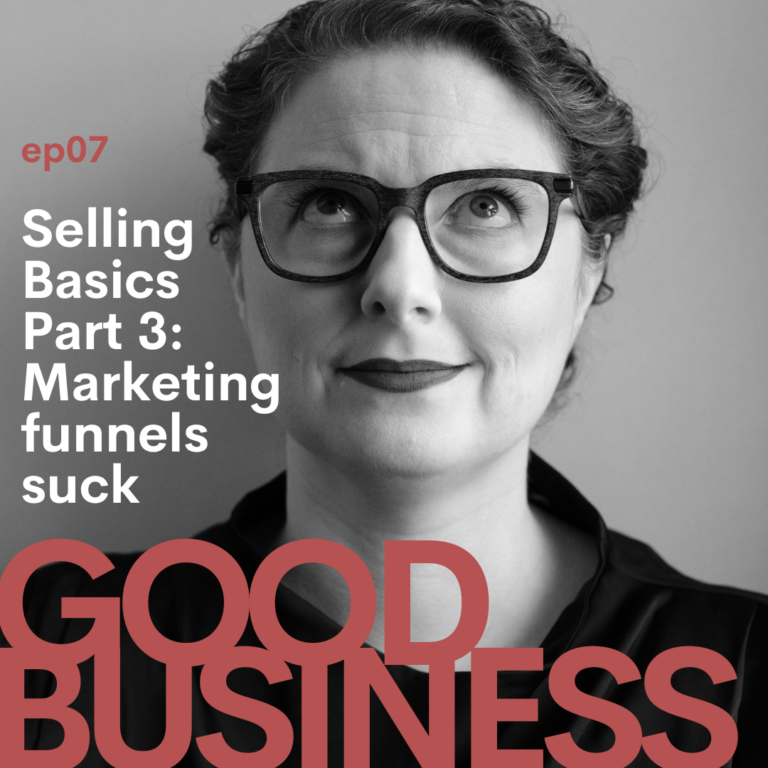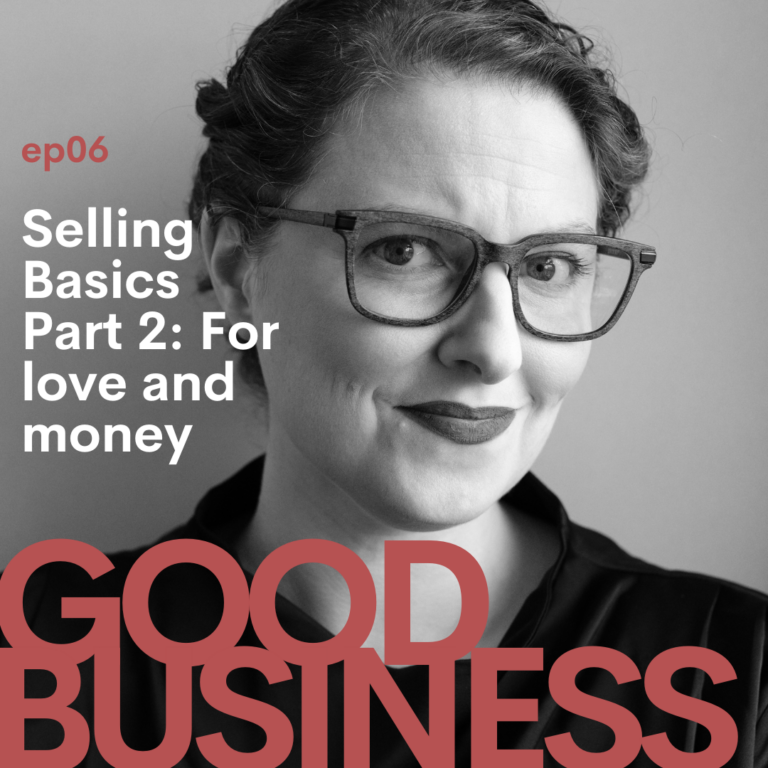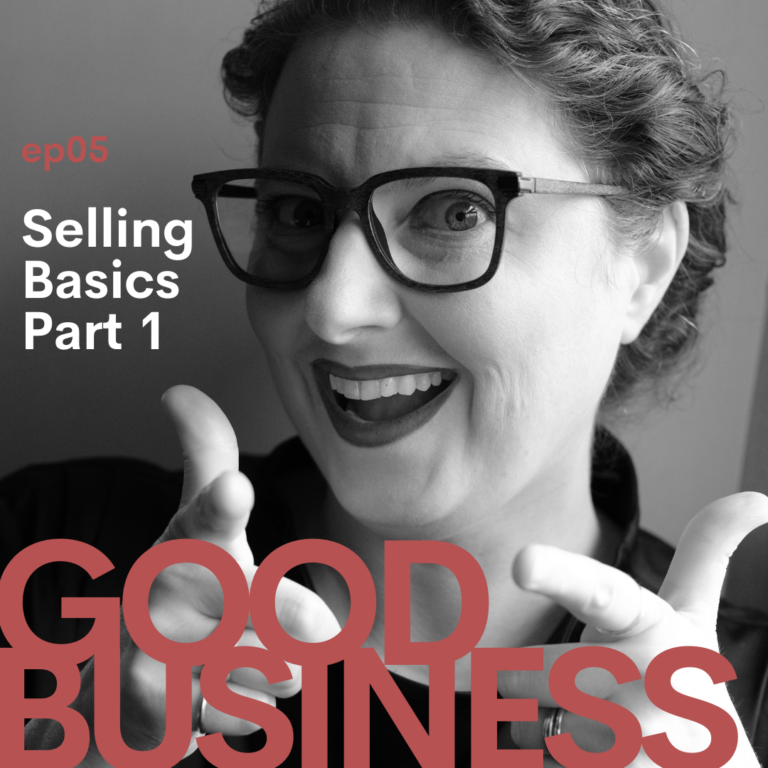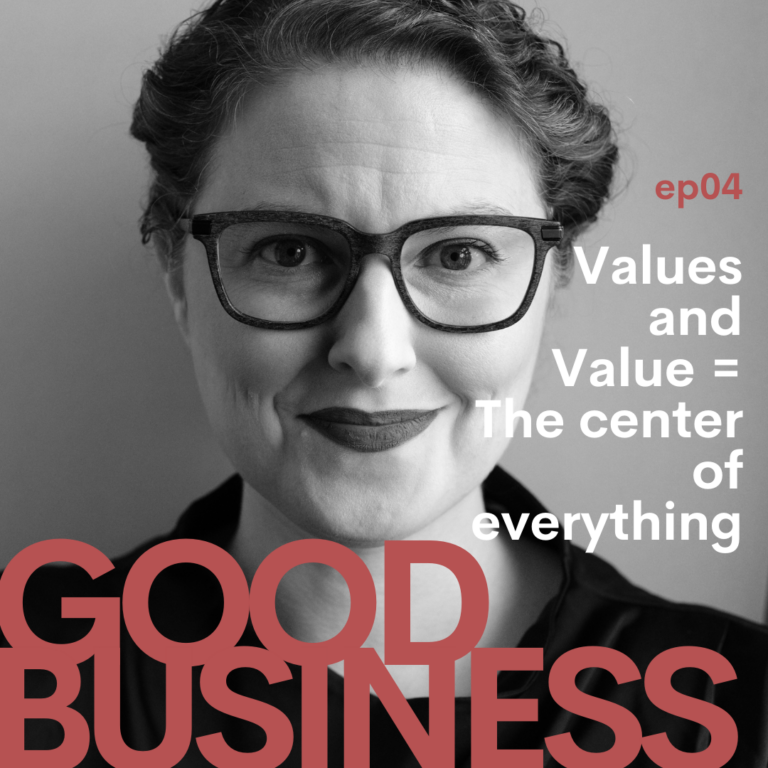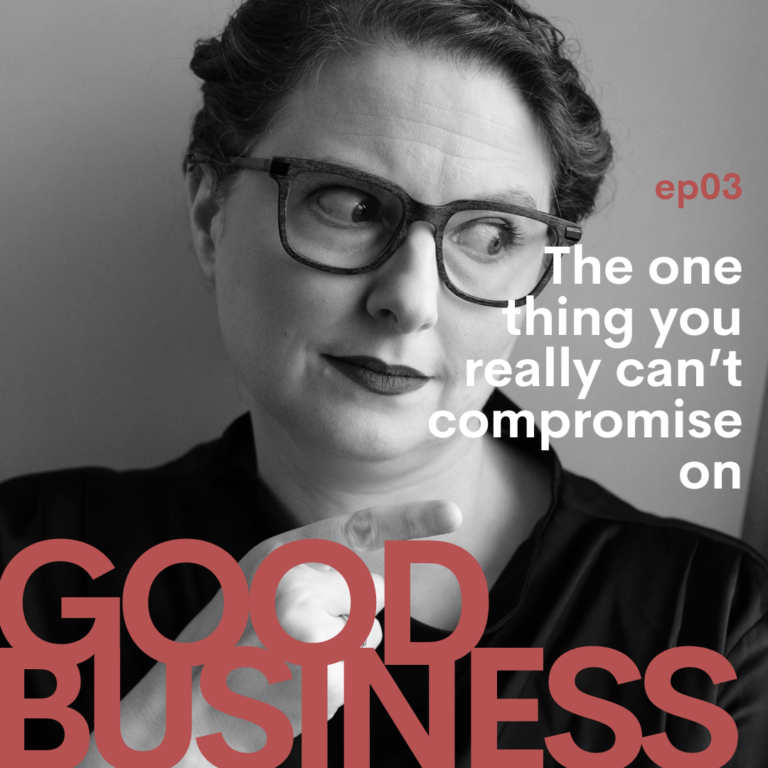Episode Transcript:
I’m Illana Burk, CEO of Your Life’s Workshop, coach to entrepreneurs and solopreneurs across dozens of industries and host of Good Business. With nearly 20 years experience helping hundreds of clients create profitable, ethically driven and sustainable businesses based on their life’s work, I’m here to teach you how to do great work, make great money, and make a positive impact without feeling like you need a shower afterwards.
Hi there, and welcome to the first real episode of the Good Business podcast. Today we’re going to jump right in to talking about one of the biggest mistakes that I see people making over and over and over again when they start their own thing. So to set that up, I know that that’s a big promise and you hear that all the time, right? Like, what’s the biggest mistake? or “Here’s the top 3 Things Everybody Does Wrong.” That’s not what we’re doing today. I’m really talking from my experience of over a decade of helping small businesses. This is the most important thing. That’s why I’m doing it as my first episode because this is the most important thing. This is the thing I see that gets people off on the wrong foot, that spins them towards failure, that gets them frustrated that they’re not making money or sales.
It’s such an easy thing to fix because it’s tied directly to ego. We’re going to get to that in a minute. But to set this up, l want to kind of paint the picture. When you start a business, oftentimes you’re leaving a work life behind. You’re leaving your corporate business or you’re leaving your corporate job. And you start to dream. You’ve been dreaming of this for so long. So you’re thinking about how this is my bliss, this is my life’s work, this is everything I’ve always wanted. And it gets so easy to focus on that, you start to lose track of all of the other things. I see people come to my coaching practice all the time that are like, “I just left my job,” or maybe “I’m doing a side hustle and I want to start my business and I want to get things underway.”
And it starts with how can I make this MY thing? It always starts from the ego. It starts from a place of “I want to start something magical”. Maybe you want to make a dent in the world. Maybe you want to start something small. Maybe you want to start something large. It doesn’t really matter, but you’re creating something that feels like it’s birthing from your soul, right? And when you’re doing that, it gets so easy to completely lose track of what actually matters to make a living. When you’re creating a solo business or, endeavoring to do really anything that you want people to spend money on, whether it’s small or big, it doesn’t really matter. So what we’re talking about today is the ability to set your own ego aside when you’re creating a brand.
Because ultimately, this is the core of it. This is the magic stuff. So settle in, take some notes. This is the most important thing. Your business isn’t about you. And it’s like the hardest thing for people to understand. It’s the hardest thing when you’re starting out because you want so badly for it to be about you. You want it to be something that’s just yours. And unfortunately, the honest truth is it can’t be. You have to start thinking about, what problem am I solving? What problem am I solving that people know that they have? And beyond that, what problem am I solving that people know that they have, AND are willing to pay for? And that they can convey? So the mistake that people make is they create a website, they create a brand.
It’s a reflection of their taste and their loves and their desires and their deepest wishes and their desire to help. And it all comes from the wrong place and adds up to the wrong thing because it’s not about you. It’s about the person that you want to serve. It’s about the person you want to help. You can bet that when Coca Cola designs a new ad campaign, the CEO isn’t thinking, how is this an expression of my deepest work in the world? They’re thinking how can I sell more soda? So no matter what you’re doing, no matter what you’re offering, no matter what you’re selling, fundamentally the only thing that matters in order to do the work is whether you can sell the work. So in order to sell the work, people have to know that you care more about what they need than what you need.
When we think about this, this often comes up mostly in branding, in how you visually represent. I think this is especially true among women because we are kind of more visual creatures about these things. We tend to gravitate towards aesthetics more. This is not to say that aesthetics don’t matter. This is to say that aesthetics only matter to the person viewing it. Now, of course you need to love your brand. Of course you need to love the design of what you create, but it’s definitely not the most important thing that you love it. The most important thing is that it resonates with the people that you most want to sell to. Because if it doesn’t, you’ve created an even steeper mountain for yourself.
If you create something that doesn’t resonate for the people that you most want to reach, you’re creating a situation where now you have to overcome that in order to get them to care. And in the competitive market that we all live in, that’s not always realistic. So what I want to talk about today, beyond that is how to think about that differently, how to pay attention to what matters to you differently, how to address what matters to your customers and to your potential clients absent of your own ego. And this is the hardest thing in the world. Hiring a good designer can help, of course, but understanding what’s beyond that. This is the important part. This is where we get to the meat of it. If you aren’t paying attention to your tastes then how do you know, how do you know when it’s the right thing?
And of course you want to have a brand you’re proud of, that you like, that you want to show off, but how do you know what is the right thing? We’re going to talk about that for a little bit. The first step is you have to figure out the values of the people that you work with and that you want to work with. You have to figure out what matters to them and what they might want from you. We oftentimes think about what the product is that we’re delivering first. But usually, the product matters less than the values of the person selling it. You know? For the most part, people aren’t generally searching for your offer, and if you’re listening to this right now, nobody’s competitively shopping for what you offer.
Let’s be honest here. We’re Solopreneurs, we’re leaders and for the most part it’s like we’re not the people that are going on Amazon and reading reviews to hire a better life coach or a better web designer or a better copywriter. That’s not the space that we’re in. What we’re talking about here is something different. This is a new industry. This is a new space. This is a new invention of how commerce works and how people connect with one another. So the first step to figuring that out is what are the values of the people that you most want to serve? And also what do they value? It’s a two fold question. The idea of values in this context is very complicated.
Honestly, I kind of wished that there was a different word for one of them. There’s not. “What do they value,” means what is it that matters most to them in the context of what you’re offering? I’ll use my own business as an example. I’m a business coach. So what matters to the people that hire me is whether or not I can help them be better at business. Whether or not I can help them make more money, whether or not I can teach them how to sell better. That’s what they value in my work. They value my attitude. They value the way that I approach their work. They value my commitment to our relationship. Those are all things that they value highly, meaning those are things that are part of what they’re paying for.
So beyond that, their values are different. So that’s more like they value honesty. They value integrity, they value a clear sense of what the best way to do business is and what the shitty way to do business is. So aligning those two things is very complicated. It requires a lot of work. And, once you know those things, then you can start to think about the visuals that make sense for those people. This is like the step beyond target marketing. It doesn’t matter what your people eat for breakfast. It matters what they value. So when you think about designing a brand, you have to think about it in the context of, how do I visually and verbally, and by verbally, I mean in writing because you know, you might use video, but it’s probably most likely a lot of writing on your website.
How do you express that you align with the values of the people that you most want to connect with? Let’s say you are creating a brand and you’re a travel writer and you want to create a brand around, helping people to have great experiences on family trips. And that’s what you want to sell. Maybe the thing you’re selling is that you can plan family trips in exotic locations, that most families usually don’t travel to with kids. And you’re going to sell them something that’s going to make that simple for them so that more adventurous travelers can have more exotic experiences. So you think about what they value, right? They’re going to value safety, they’re going to value a sense of security, they’re going to value a lot of experience and their values are around what you offer are going to include: they need you to be stable. They need you to show off that you’ve been to the places that you’re talking about going. They need to know that you have the experience that they can rely on and the credibility that they can rely on in order to put their family’s life in your hands.
And they’re willing to pay for it when you can prove that. So when you think about visuals and you’re thinking about brand development, you’re thinking about how to express that. Here’s the mistake point. You’re setting out on your own and the first thing you do is, “what colors do I like?” What fonts do I gravitate towards? And you make the mistake of thinking that your taste is aligning with what you want to do in the world. And that’s extremely, extremely, extremely unpredictable and rare. Like, so rare.
I’m not sure I’ve ever seen it before. Oftentimes what we like and our taste and what we gravitate towards has to do with our own life experience. It has to do with our own general likes and dislikes in the world. It has to do with the colors on the wall and our family home where we grew up and has very little to do with accessing the people that you most want to serve and help and offer assistance to. So you need to think about that in the scope of like, okay, so instead of posting a bunch of pictures of me taking selfies hanging off of the edge of the empire state building or something crazy like that. Yes, that shows adventure, but it doesn’t actually convey what your people need you to convey.
They need to convey safety. They want to see an amazing picture of the top of the empire state building. But they don’t want to see you hanging off of it, right? You have to consider that as you design a brand, it’s way more about what the market needs, what your people need than it is about what YOU need. So with that, I think I’m going to call it a day here, and I want you to think about what you can do and what your brand is conveying that it’s not about you, right? Take a look at what you’ve got and think about the choices that you made. Every single piece of your website, every single piece of your brand should have a purpose. If it doesn’t have a purpose, it doesn’t belong. And if it’s not conveying the right message to the right people that you care about them more than you care about yourself in the context of your business, then it’s doing you a disservice and it’s making your job harder. So I hope you guys enjoyed our very first episode today. I encourage you to like and share and do all the things and subscribe if you’d like and have a really wonderful day and I’ll see you next week.
Thanks so much for hanging out with me today. For more information, visit TheGoodBusiness.co or YourLifesWorkshop.com.
More Episodes
Strategy vs. Tactics -OR- Why, “Doing Instagram,” is NOT a strategy, and that’s why it’s not working. | GB08
Understanding the difference between strategy and tactics is a critical skill in business leadership, and is the one most solopreneurs completely skip. Today’s episode offers a primer on what each actually ARE, how to use them, and how to ask yourself the harder questions that will lead to success.
The Ethical Selling Part 3: Marketing Funnels Suck | GB07
Marketing Funnels. What they are (and aren’t). Why I think they’re a terrible way to structure a client relationship. And what to do instead. The idea today is to show you why and how to look deeper at the prevalent logic that you HAVE to do this to be successful. You don’t.
Selling Basics Part 2: For love and money | GB06
Today’s focus is on how to love selling by loving your clients (or potential clients) first. Loving the people you’re selling to is a HUGE part of making selling into something you adore. It’s not just an esoteric concept. It’s...
Selling the right way: Part 1 | GB05
Selling is a conversation. A communication. It’s how you show yourself to your community. The confusion happens when we see people we like, look up to, and respect using sales tactics that belie their stated mission.
Values and Value: The Center of EVERYTHING | GB04
Your values affect your your deepest work, how you make decisions, how you operate externally from yourself. It’s how you move through the world. Your value is how other’s experience it. Today’s episode is a deep-dive primer on why understanding both is critical.
The one thing to never compromise on | GB03
Business is FULL of opportunities for compromise. Options. Bad advice. The kind that tells you it’s OK to sacrifice your values. And as business owners, we are often asked to bend, shift, stretch. Change what we KNOW to be true to fit “The Rules”. Today we explore the one thing to NEVER do this on.


